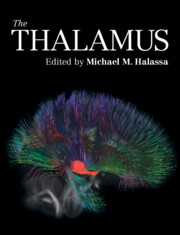Book contents
- The Thalamus
- The Thalamus
- Copyright page
- Contents
- Contributors
- Preface
- Section 1: History
- Chapter 1 A Brief History of Thalamus Research
- Section 2: Anatomy
- Section 3: Evolution
- Section 4: Development
- Section 5: Sensory Processing
- Section 6: Motor Control
- Section 7: Cognition
- Section 8: Arousal
- Section 9: Computation
- Index
- References
Chapter 1 - A Brief History of Thalamus Research
from Section 1: - History
Published online by Cambridge University Press: 12 August 2022
- The Thalamus
- The Thalamus
- Copyright page
- Contents
- Contributors
- Preface
- Section 1: History
- Chapter 1 A Brief History of Thalamus Research
- Section 2: Anatomy
- Section 3: Evolution
- Section 4: Development
- Section 5: Sensory Processing
- Section 6: Motor Control
- Section 7: Cognition
- Section 8: Arousal
- Section 9: Computation
- Index
- References
Summary
Modern views on thalamus structure and function are the outcome of a long process of scientific discovery that started centuries ago and is still ongoing. As for other brain systems, strides along this path followed, to a large extent, from the introduction of new research tools capable of providing increasingly accurate delineations of neuronal connections and functional properties. These discoveries, in turn, expanded or corrected previous theories about thalamus operation and the contributions of the thalamus to behavior. Here, I summarize the key steps of this process, from the early descriptions of macroscopic anatomy and lesion effects through electrophysiological, neurochemical, and pathway-tracing studies to current connectomic, functional, and transcriptome investigations at the single-cell and brain-wide level.
- Type
- Chapter
- Information
- The Thalamus , pp. 1 - 26Publisher: Cambridge University PressPrint publication year: 2022



